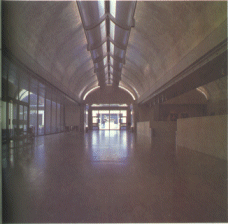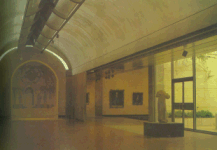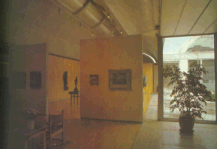

"Space has tonality, and I imagine myself composing a space lofty, vaulted, or under a dome, attributing to it a sound character alternating with the tones of spaces, narrow and high, with graduating silver, light to darkness" -Kahn
Kimbell Art Museum was conceived as a succession of rooms defined by an integrated system of lighting. The cycloidal vaults fulfilled Kahn's dreams by defining spaces through the unification of light and structures. Indoors and outdoors were no longer divided by a simple wall with openings, as in his early works. The interface became multi-layer space in which light is modulated.
In addition to the natural vault lighting, Kahn also employed the use of skylights and courtyards, window slits on exterior walls and lunettes under the vaults to introduce and vary the intensity of natural light into the building.



Skylighting of the galleries allow the "comforting feeling of knowing the time of the day"as Kahn had mentioned.
More successful in conveying the natural variety of light were the tiny glass-walled courtyards which Kahn brought the outside world into the galleries. This he spoke of as "A counterpoint of courts, open to the sky, of calculated dimensions and character, marking them Green Court, Yellow Court, Blue Court, named for the kind of light that [he] anticipate[s] their proportions, their foliation, or their sky reflections on the surfaces, or on water will give". This also applies to his varied use in materials , both achieving different moods of light within the gallery.